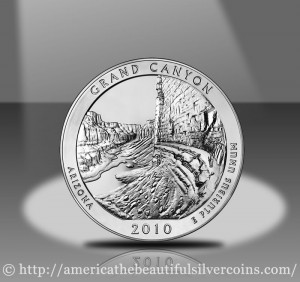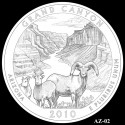The 2010 Grand Canyon America the Beautiful Silver Bullion Coin is the fourth issue in the United States Mint’s new multi-year series that honors national parks and sites. This silver bullion coin celebrates Grand Canyon National Park located in the state of Arizona.
These Grand Canyon Silver Coins were finally issued for sale to the US Mint’s network of authorized purchasers on December 10, 2010. The strikes were released late in the year as the US Mint initially had difficulties in striking them owing to their size and the requirement of an edge inscription.
Overcoming the obstacles, the Mint had planned to release the coins a few days earlier in December 2010, but reports of price gouging concerns by the Authorized Purchasers led the Mint to delay sales while it instituted a new policy for the coins. With the new requirements in place, the Grand Canyon Silver Coins as well as the other four 2010-dated strikes of the series were finally released on December 10th. By the end of the month, the entire mintage of 33,000 per strike had been ordered.
The 2010 Grand Canyon America the Beautiful Silver Bullion Coin features the same designs as that on the companion Grand Canyon National Park Quarter. However, unlike the quarter, the U.S. Mint strikes the silver bullion versions out of .999 fine silver to a weight of five ounces and to a full three inches in diameter. Therefore, the silver bullion images are larger, and the coins themselves double the size of early American coinage, like the Morgan silver dollars.
Creating a design that must be placed on the smaller quarter and is emblematic of the Grand Canyon National Park is no easy chore. The Grand Canyon is up to 18 miles wide, about a mile deep, and about 277 river miles long. The river is crooked, not straight, and has been carving out the canyon for thousands of years. Choosing one scene in an area rich in color, uniqueness, and size is up to the U.S. Mint and its artists, two government advisory groups, site officials, and the U.S. Secretary of the Treasury.
The final design, shown above, was revealed on March 24, 2010. Prior to its selection by the Treasury Secretary, four candidate designs were created that represent the national park in Arizona. The artwork was submitted to the Citizens Coinage Advisory Committee (CCAC) and the United States Commission of Fine Arts (CFA) — organizations that review American coinage and medal designs and offer recommendations to the U.S. Mint Director and the Secretary of the Treasury.
For reference, these designs, in line art image form, are shown below along with accompanying CCAC and CFA comments. Each image may be enlarged with a click:
Although it does not always happen, in this case both the CCAC and CFA chose the same design, "AZ-01." This was also the one selected as the template for the final coins. In it, the Nankoweap Granaries are showing in the right wall of the canyon as the river winds along the bottom.
"The Committee narrowly prefers design 1, featuring a canyon-level view of the granaries above the Nankoweap Delta, over design 4, which features an aerial view of the canyon," the CCAC reported to Treasury Secretary Geithner. "Both were considered to be powerful images, with design 1 preferred for its more immediate, human-scaled view of the canyon."
"The Commission acknowledged the difficulty of distinguishing the subject from its previous depiction on the Arizona state quarter, a concern that may recur over the course of this new series," CFA Secretary Thomas E. Luebke said in a report to US Mint Director Ed Moy. "The Commission recommended alternative #1, due the depth of the perspective view, but suggested several modifications. Noting that the foreground is given too much dominance in the composition, the Commission members recommended shifting the strong vertical alignment at the center of the coin to the right to emphasize the deep perspective toward the left side of the composition."
2010 Grand Canyon America the Beautiful Silver Bullion Coins are not sold directly by the Mint to the public, but instead to a select group of authorized buyers (coin dealers, precious metal providers, etc.) who then resell the coins.
56 U.S. National Parks and Sites, one for each state, the District of Columbia and the five U.S. territories, have been selected to be on the 5 oz silver coins and companion quarters. The series will last eleven years, with five new designs per year, and finish with the last design in 2021.
The United States Mint will also be releasing a collector grade version of this coin known as the Grand Canyon Silver Uncirculated Coin.
Grand Canyon National Park in Arizona
"Modern man" would first discover the beauties of the Grand Canyon in 1540 when Captain Garcia Lopez de Cardenas and his Spanish solders would visit the area along with some Hopi Indian guides. Not being what they were searching for, the Spanish soldiers left and it would be over 200 years before the area would be "discovered" again.
It was not until the mid 1800’s that explorers made any meaningful advances in understanding the area. Several expeditions, some of the military in nature, were dispatched in the 1850’s but the most scientifically credible one occurred in 1869, with an expedition led by Major John Wesley Powell. Powell was an accomplished explorer who took nine men and four boats down the Colorado River through the Grand Canyon. He repeated his trip again in 1871, creating a detailed map of the river and had multiple photos taken of the area.
In 1903, President Theodore Roosevelt visited the area in Arizona and was decidedly impressed. He took the first steps to protect the Grand Canyon by making it a Federal Game Preserve in 1906. However, he, along with other area supporters, was not happy with the protection this afforded and made it a National Monument in 1908.
Opponents prevented its induction as a National Park until 1919, when it became the 17th such park in the United States. Today, almost 5 million people visit the park each year.




